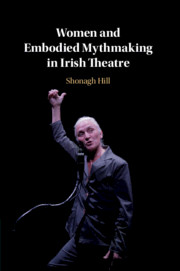Book contents
- Women and Embodied Mythmaking in Irish Theatre
- Women and Embodied Mythmaking in Irish Theatre
- Copyright page
- Dedication
- Contents
- Acknowledgements
- Introduction: A Creative Female Corporeality
- Chapter 1 Revolutionary Bodies: Mythmaking and Irish Feminisms
- Chapter 2 Unhomely Bodies: Transforming Space
- Chapter 3 Metamorphic ‘Bodies That Matter’: Process and Resistance
- Chapter 4 Staging Female Death: Sacrificial and Dying Bodies
- Chapter 5 Haunted Bodies and Violent Pasts
- Chapter 6 Olwen Fouéré’s Corpus: The Performer’s Body and Her Body of Work
- Bibliography
- Index
Chapter 2 - Unhomely Bodies: Transforming Space
Published online by Cambridge University Press: 29 August 2019
- Women and Embodied Mythmaking in Irish Theatre
- Women and Embodied Mythmaking in Irish Theatre
- Copyright page
- Dedication
- Contents
- Acknowledgements
- Introduction: A Creative Female Corporeality
- Chapter 1 Revolutionary Bodies: Mythmaking and Irish Feminisms
- Chapter 2 Unhomely Bodies: Transforming Space
- Chapter 3 Metamorphic ‘Bodies That Matter’: Process and Resistance
- Chapter 4 Staging Female Death: Sacrificial and Dying Bodies
- Chapter 5 Haunted Bodies and Violent Pasts
- Chapter 6 Olwen Fouéré’s Corpus: The Performer’s Body and Her Body of Work
- Bibliography
- Index
Summary
This chapter focuses on how the theatrical forms utilized in Paula Meehan’s Mrs Sweeney (1997) and Mary Elizabeth Burke-Kennedy’s Women in Arms (1984, 1988 and 2002) encapsulate the tension between the body and the space it inhabits, and how the process of their mutual reshaping negotiates the expression of women’s unhomely experience. The tension between body and space offers a node through which the unhomely experience emerges in these two plays through exploration of both the home and the landscape. Mrs Sweeney and Women in Arms adopt very different theatrical forms, including the carnivalesque and Brechtian theatre, to map the complex ways in which space and body intersect; yet both suggest that realism is inadequate to the task of expressing women’s desires and look to alternative forms to carve out new spaces of expression. Counter to the limits of realism, the energy of resistance together with the suggestion of transformation and change invigorates both Mrs Sweeney and Women in Arms.
- Type
- Chapter
- Information
- Women and Embodied Mythmaking in Irish Theatre , pp. 65 - 103Publisher: Cambridge University PressPrint publication year: 2019

